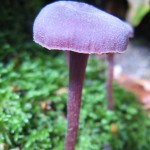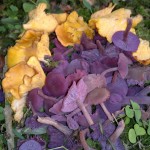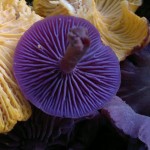Amethyst deciever – identification, edibility, distribution
Laccaria Amethystina
- Edibility 2 – pleasant enough, though a little flimsy
- Identification 4 – Cap 1-3cm, amethyst purple when damp, drying to greyish hues; gills broadly spaced, often partial; stipe concolorous with cap and gills, narrow, hollow. Pulled from the ground, they usually come with some cottony looking fibres attached to the stipe base. Lilac Bonnet (also edible) is much paler (pink, not amethyst); Lilac fibrecap (poisonous) is also much paler (though remember, amethyst deceivers can look paler in dry weather!), with white gills that become walnut brown as spores mature.
- Distribution 5 – Very common, often in huge numbers
- Season: July-November
- Habitat: Any woodland especially deciduous, most commonly beech
Though not strong in flavour and a little flimsy of texture, these mushrooms are well worth picking for their beautiful colour, which is even more striking in a basket next to chanterelles – which they can often be found growing alongside. Sadly the colour does not survive cooking.



2 Comments
Hi,
Could you please tell me how is best to correctly discern the mushroom from the lilac bonnet?
Thanks,
Cam.
Hi Cam,
I’ve added more info above. Hope it helps. Probably best to check in a good fungi guidebook if you still aren’t sure.
Cheers,
Mark.